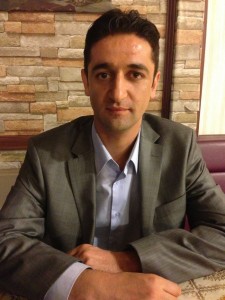
Obadah Alkadri / image: KPBS
Last week I asked what outside and independent news and information sources are available inside Syria. In particular, I wondered what radio outlets are available.
Tom Fudge, news director of KPBS, provides an answer to my question in a story aired last Thursday. He talked with a handful of independent Syrian journalists who visited San Diego in a State Department sponsored trip, one of whom is part of a group that is making clandestine radio broadcasts inside that country.
Obadah Alkadri is the manager of Damascus News Agency and the Alkadri Group for Media Production that were started at the beginning of the Syrian revolution. Alkadri said that his organizations are transmitting from inside Damascus, taking steps to avoid detection by state police. He told Fudge
“So we divided Damascus into 15 sections. In each section we put one radio transmitter. We are playing this radio just for 20 minutes. After that, we turn it off and we will start again in another section, and turn on the other one.”
The main studio is located in Istanbul because Syria has unreliable electricity and internet. They communicate with journalists on the ground inside Syria using satellite phones and internet which are not easily intercepted by local authorities.
Alkadri said that they put transmitters in “liberated areas,” but that they are paying some groups of the FSA to protect their offices.
Running only 20 minutes at a time should make it quite possible to run the transmitters off of batteries. A lead-acid motorcycle battery can run even a 100 watt transmitter for quite some time.
I would like to know a few more technical details about the broadcasts. For instance, are the broadcasts all on the same frequency? That would make the most sense to me, since it would not require listeners to try and relocate the signal on the dial.
It would be interesting to know how the broadcasts are publicized.
It’s likely that the government knows about the broadcasts, but it may be advantageous to keep some unpredictability in their timing. This is a tactic that has been used by unlicensed broadcasters around the world looking to evade detection. Of course, the challenge is in making sure your intended audience is able to find and listen to your broadcast.
I am not at all surprised to learn that there are brave journalists broadcasting independent radio inside Syria. Radio transmitters can be small, light and portable, easily set up and taken down quickly. At the same time, even low powered broadcasts can reach thousands of people at once. Even when power is unreliable both transmitters and receivers can run on rechargeable batteries.
Especially when the internet and electricity are not easily available, radio is still an important and viable tool for communications freedom.


